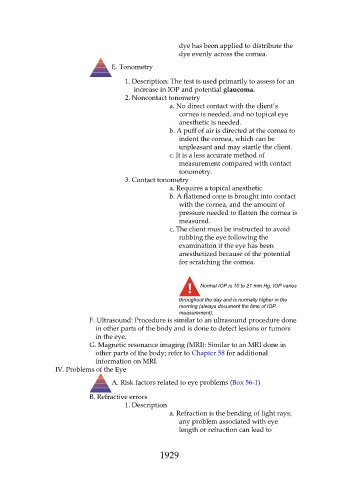Page 1929 - Saunders Comprehensive Review For NCLEX-RN
P. 1929
dye has been applied to distribute the
dye evenly across the cornea.
E. Tonometry
1. Description: The test is used primarily to assess for an
increase in IOP and potential glaucoma.
2. Noncontact tonometry
a. No direct contact with the client’s
cornea is needed, and no topical eye
anesthetic is needed.
b. A puff of air is directed at the cornea to
indent the cornea, which can be
unpleasant and may startle the client.
c. It is a less accurate method of
measurement compared with contact
tonometry.
3. Contact tonometry
a. Requires a topical anesthetic
b. A flattened cone is brought into contact
with the cornea, and the amount of
pressure needed to flatten the cornea is
measured.
c. The client must be instructed to avoid
rubbing the eye following the
examination if the eye has been
anesthetized because of the potential
for scratching the cornea.
Normal IOP is 10 to 21 mm Hg; IOP varies
throughout the day and is normally higher in the
morning (always document the time of IOP
measurement).
F. Ultrasound: Procedure is similar to an ultrasound procedure done
in other parts of the body and is done to detect lesions or tumors
in the eye.
G. Magnetic resonance imaging (MRI): Similar to an MRI done in
other parts of the body; refer to Chapter 58 for additional
information on MRI.
IV. Problems of the Eye
A. Risk factors related to eye problems (Box 56-1)
B. Refractive errors
1. Description
a. Refraction is the bending of light rays;
any problem associated with eye
length or refraction can lead to
1929

